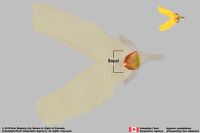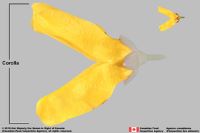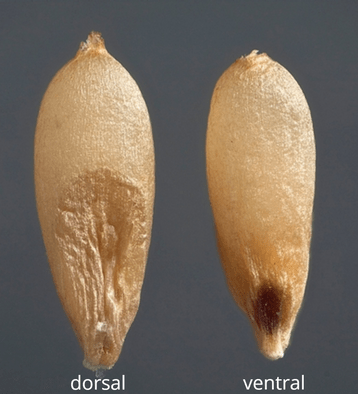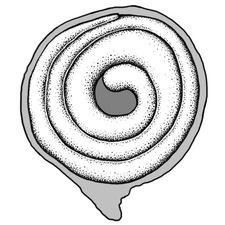Content is from Kirkbride et al. 2006Kirkbride et al. 2006:
Kirkbride JH, Jr, Gunn CR, and Dallwitz MJ. 2006. Family guide for fruits and seeds, vers. 1.0. Accessed September 2020-January 2022. URL: https://nt.ars-grin.gov/seedsfruits/keys/frsdfam/index.cfm ., without modification.
Updates are forthcoming.
Fruits: Pistil(s) compound; 1; 1-pistillate; with carpels united. Fruit anthocarpanthocarp:
simple or compound and including some tissue of non-ovarian origin (accessory tissue) , or pericarpium; schizocarpschizocarp:
, or pericarpium; schizocarpschizocarp:
usually dry fruit splitting between two or more locules to form distinct, indehiscent, usually one seeded segments; fruit derived from a single, superior or inferior, compound ovary; compare to mericarp ; coccarium (Brunia paleacea P. J. Bergius); simple; cypselacypsela:
; coccarium (Brunia paleacea P. J. Bergius); simple; cypselacypsela:
dry, indehiscent, unilocular fruit with a single seed not adnate to the pericarp, similar to an achene but developed from an inferior ovary. Fruit type of Asteraceae. (Brunonia australis Sm.), or diclesium (Berzelia abrotanoides Brongn.); without persistent central column; crowned by sepalssepal:
(Brunonia australis Sm.), or diclesium (Berzelia abrotanoides Brongn.); without persistent central column; crowned by sepalssepal:
a member of the outer envelope of a flower (calyx) (commonly by calyxcalyx:
(commonly by calyxcalyx:
the outer whorl of the perianth; all the sepals of a flower or corollacorolla:
or corollacorolla:
the inner whorl(s) of the perianth; all the petals of a flower & androecium); within accessory organ(s), or not within accessory organ(s); within calyxcalyx:
& androecium); within accessory organ(s), or not within accessory organ(s); within calyxcalyx:
the outer whorl of the perianth; all the sepals of a flower ; persistent; 1-seeded (for nutnut:
; persistent; 1-seeded (for nutnut:
a fairly large, indehiscent, dry fruit with a thick and bony wall surrounding a single seed, derived from a single, simple or compound ovary ), or more than 1 but less than 10-seeded (for capsulecapsule:
), or more than 1 but less than 10-seeded (for capsulecapsule:
a dry, dehiscent fruit derived from a compound ovary ); 1–2-seeded; with 2-carpellate (1–3); without sterilesterile:
); 1–2-seeded; with 2-carpellate (1–3); without sterilesterile:
lacking male and/or female reproductive parts; also, not producing fruit or seed
 carpels; not sulcatesulcate:
carpels; not sulcatesulcate:
surface relief—having one or more elongate, relatively narrow and shallow depressions or grooves ; apexapex:
; apexapex:
the point farthest from the point of attachment, or the "tip" of an organ not beaked; indehiscentindehiscent:
not beaked; indehiscentindehiscent:
not opening on its own, as in a fruit
 , or dehiscentdehiscent:
, or dehiscentdehiscent:
(v. dehisce) splitting open at maturity to release contents (of a fruit) . Dehiscentdehiscent:
. Dehiscentdehiscent:
(v. dehisce) splitting open at maturity to release contents (of a fruit) regularly; linearly; by ventralventral:
regularly; linearly; by ventralventral:
adaxial; of the side of an organ facing the axis (compare dorsal)
 sutures; and shedding seeds; without replumreplum:
sutures; and shedding seeds; without replumreplum:
the rim, formed by the persistent placentas, and connected by a false septum in Brassicaceae fruits. The fruit valves are attached to this rim and separate from it in dehiscent fruits.
. Epicarpepicarp:
outer layer of fruit wall or pericarp, if divided into layers; note here used synonymously with exocarp durable; sub coriaceouscoriaceous:
durable; sub coriaceouscoriaceous:
texture—leathery
, or thin, or thick; not glabrousglabrous:
without hairs
(with hairs); hairs dense; hairs red, or yellow; hairs not glandularglandular:
surface relief—covered with small, raised secretory glands, regular or irregularly shaped, translucent or opaque, and maybe distinctly colored ; without armature, or with armature; with lignified trichomes; without wing(s); without apicalapical:
; without armature, or with armature; with lignified trichomes; without wing(s); without apicalapical:
at or pertaining to the end of the seed or fruit distal from its point of attachment (i.e., base)
respiratory hole. Endocarpendocarp:
the inner layer of the pericarp, if divided into layers present; separating spontaneously from exocarpexocarp:
present; separating spontaneously from exocarpexocarp:
outer layer of fruit wall or pericarp, if divided into layers; note here used synonymously with epicarp ; thin; not splitting into 1-seeded pyrenes; smooth; without wing; without operculumoperculum:
; thin; not splitting into 1-seeded pyrenes; smooth; without wing; without operculumoperculum:
a dehiscent cap (or lid) of a seed or fruit that opens during germination or dehiscence ; without secretory cavities; without mechanism for seedling escape; without grooves; without longitudinallongitudinal:
; without secretory cavities; without mechanism for seedling escape; without grooves; without longitudinallongitudinal:
of or relating to length or the lengthwise dimension
ridges. Funiculusfuniculus:
(alt. funicle) stalk connecting the ovule (later seed) to the ovary (later fruit) placenta short; short without seed bearing hookswith hooks:
short; short without seed bearing hookswith hooks:
bristles or spines with curved or backwards pointing tips, or with secondary bristles along their length (retinacula); not persisting in fruit after seed shed.
(retinacula); not persisting in fruit after seed shed.
Seeds: Arilaril:
(broad sense) appendicular structure that wholly or partly envelops a seed and is produced from or a modification of the funicle, raphe, or outer integument; usually fleshy or pulpy, sometimes spongy or tufted-capillate, often brightly colored present, or absent; a true arilaril:
present, or absent; a true arilaril:
(broad sense) appendicular structure that wholly or partly envelops a seed and is produced from or a modification of the funicle, raphe, or outer integument; usually fleshy or pulpy, sometimes spongy or tufted-capillate, often brightly colored ; adnate to hilumhilum:
; adnate to hilumhilum:
on seeds, the scar indicating where the funiculus was attached; on grass caryopses, the scar visible on the outer fruit surface revealing where the seed is attached on the inner fruit wall surface; or in Asteraceae cypselae, the scar visible on the outer fruit wall revealing where the fruit was attached to the receptacle ; of funicularfuniculus:
; of funicularfuniculus:
(alt. funicle) stalk connecting the ovule (later seed) to the ovary (later fruit) placenta origin; basalbasal:
origin; basalbasal:
at or pertaining to the point of attachment; (of embryo) embryo occupies one end of the seed
; does not aid in seed explusion from fruit; cupshaped. Seed larger than minute; oblongoblong:
2D shape—much longer than broad with nearly parallel sides, corners are rounded , or ellipsoidellipsoid:
, or ellipsoidellipsoid:
3D shape—elliptic
, or circularcircular:
(of embryo) linear embryo is curved into an "O" shape , or angularangular:
, or angularangular:
2D shape—having sides that meet at acute or obtuse angles
; not bowl shaped; not nutlike; without winglike beakbeak:
a usually firm, terminal appendage, sometimes tapered ; without caudatecaudate:
; without caudatecaudate:
tapering to a long, tail-like appendage appendage(s); at maturity with food reserves; with endosperm; without canavanine. Sarcotestasarcotesta:
appendage(s); at maturity with food reserves; with endosperm; without canavanine. Sarcotestasarcotesta:
pulpy or fleshy outer layer of the seed coat, simulates aril absent. Testatesta:
absent. Testatesta:
seed coat
 present; without fleshy or leatheryleathery:
present; without fleshy or leatheryleathery:
texture—moderately thick, tough, and very pliable
layer over hard layer; surface unsmooth, or smooth; surface with merged raised features; surface wrinkledwrinkled:
surface relief—shallow, irregular folds and furrows covering the surface; appearing overall though crumpled and then spread out ; without crease or line separating cotyledons from hypocotyl-radicle; without notch along margin where cotyledons from hypocotyl-radicle tip approach each other; without glands; without bristles; without wings; without collar; without operculumoperculum:
; without crease or line separating cotyledons from hypocotyl-radicle; without notch along margin where cotyledons from hypocotyl-radicle tip approach each other; without glands; without bristles; without wings; without collar; without operculumoperculum:
a dehiscent cap (or lid) of a seed or fruit that opens during germination or dehiscence ; colored; monochrome; crustaceouscrustaceous:
; colored; monochrome; crustaceouscrustaceous:
texture—thin, dry, indurate, and brittle
; not becoming mucilaginousmucilaginous:
resembling mucilage; moist and sticky
when wetted. Hilumhilum:
on seeds, the scar indicating where the funiculus was attached; on grass caryopses, the scar visible on the outer fruit surface revealing where the seed is attached on the inner fruit wall surface; or in Asteraceae cypselae, the scar visible on the outer fruit wall revealing where the fruit was attached to the receptacle larger than punctatepunctate:
larger than punctatepunctate:
surface relief—dotted with pits or with translucent, sunken glands or with colored dots, similar to pitted (hilumhilum:
(hilumhilum:
on seeds, the scar indicating where the funiculus was attached; on grass caryopses, the scar visible on the outer fruit surface revealing where the seed is attached on the inner fruit wall surface; or in Asteraceae cypselae, the scar visible on the outer fruit wall revealing where the fruit was attached to the receptacle naked or covered with fleshy cupule). Endosperm copious; fleshy; smooth; without fatty acid containing cyclopropene; without apicalapical:
naked or covered with fleshy cupule). Endosperm copious; fleshy; smooth; without fatty acid containing cyclopropene; without apicalapical:
at or pertaining to the end of the seed or fruit distal from its point of attachment (i.e., base)
lobes; without chlorophyll; without isodiametric faceted surface; without odor.
Embryo differentiated from food reserve; well developed; 1 per seed; partially filling testatesta:
seed coat
 (with food reserve); 0.1 times the length of food reserve; at one end of seed not extending into a depression or cup; axileaxile:
(with food reserve); 0.1 times the length of food reserve; at one end of seed not extending into a depression or cup; axileaxile:
on or of the axis
and centric and basalbasal:
at or pertaining to the point of attachment; (of embryo) embryo occupies one end of the seed
; linearlinear:
(shape) long, narrow, and uniform in width; (of embryo) embryo is straight and much longer than wide ; straight; with cotyledons gradually connected to hypocotyl-radicle; without coleorhiza; without simmondsin; without stomata; not green; with 2 or more cotyledons. Cotyledons 2; tiny; 0.5 times length of embryo; somewhat to significantly wider than hypocotyl-radicle (slightly); with apicesapex:
; straight; with cotyledons gradually connected to hypocotyl-radicle; without coleorhiza; without simmondsin; without stomata; not green; with 2 or more cotyledons. Cotyledons 2; tiny; 0.5 times length of embryo; somewhat to significantly wider than hypocotyl-radicle (slightly); with apicesapex:
the point farthest from the point of attachment, or the "tip" of an organ entire; with margins separate; equal in size; not punctatepunctate:
entire; with margins separate; equal in size; not punctatepunctate:
surface relief—dotted with pits or with translucent, sunken glands or with colored dots, similar to pitted dotted. Hypocotyl-radicle moderately developed; coiledcoiled:
dotted. Hypocotyl-radicle moderately developed; coiledcoiled:
(of embryo) linear embryo is very long and bent to form a coil whereby one end of the embryo is on the outside and the other end near the middle of the seed ; not thickened.
; not thickened.
Noxious weeds: 1 or more USA state noxious weeds in this family.
USA states and territories with listed noxious weeds: Florida (FL).
USA state and territory noxious weeds:
Berzelia intermedia Schltdl.: USA state noxious weed: FL°.
Symbols: ªaquatic weed; ●terrestrial weed; °weed in seed.
Last updated February 2006.
Literature specific to this family: Pillans, N.S. 1947. A revision of Brunia. J. S. African Bot. 13:121–206; Schnizlein, A. 1846–70. Iconographia familiarum naturalium regni vegetabilis, vol. 3, plate 168. Max Cohen & Sohn, Bonn.; Swartz, O. 1810. Die Pflanzen-Gattung Linconia. Mag. Neuesten Entdeck. Gesammten Naturk. Ges. Naturf. Freunde Berlin 4: 85–89.
General references: Corner, E.J.H. 1976. The seeds of Dicots, esp. vol. 2. Cambridge University Press, New York, Cronquist, A. 1981. An integrated system of classification of flowering plants, 1,262 p. Columbia University Press, New York, Engler, A. & K. Prantl. 1924 and onward. Die Natürlichen Pflanzenfamilimien. W. Engelman, Leipzig, Goldberg, A. 1986 (dicots) & 1989 (monocots). Classification, evolution, and phylogeny of the familes of Dicotyledons. Smithsonian Contr. Bot. 58 for dicots (314 pp.) & 71 for monocots (74 pp.). [Goldberg's illustrations are reproduced from older publications and these should be consulted], Gunn, C.R., J.H. Wiersema, C.A. Ritchie, & J.H. Kirkbride, Jr. 1992 & amendments. Families and genera of Spermatophytes recognized by the Agricultural Research Service. Techn. Bull. U.S.D.A. 1796:1–500, Hooker, J.D. 1873 and forward. Icones Plantarum. William & Norgate, London. (plate number cited in text within [ ]), Mabberley, D.J. 1987. The plant-book, 706 p. Cambridge University Press, Cambridge, Martin, A.C. 1946. The comparative internal morphology of seeds. Amer. Midl. Naturalist 36:513–660, and Spjut, R.W. 1994. A systematic treatment of fruit types. Mem. New York Bot. Gard. 70:1–182.